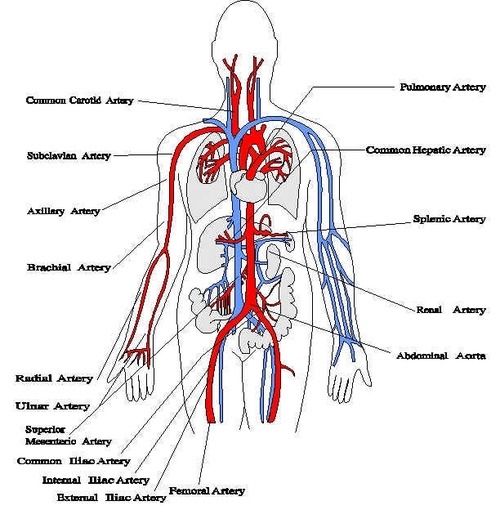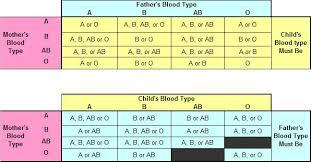Blood & Blood Splatters
Fanfic Author Resources
USEAGE:
Knowing about blood splatters can be useful for lot's of fics, especially crime & detective ones. Knowing about how blood splatters can be read can also make your character be able to truthfully and accurately determined many things, such as crime weapon used, how close it was used (guns) and even how long ago it happened. Blood in particular is important in figuring out things such as blood type inherited from families, about blood loss and it's affects and many other things.
BLOOD:
- The average human body has about 1.3 gallons (5 L) of blood
- It accounts for 7% of total body weight
- Veins are large blood vessels carrying deoxygenated blood to the lungs. The lungs oxygenate the blood with oxygen from the air. Then, the blood goes into arteries. Arteries are large blood vessels that carry the newly oxygenated blood to every corner of the body
This is a map of major arteries and veins in the human body.
- If one of these arteries or veins is cut open, the victim may bleed out within several minutes. Bleeding to death is called desanguination (massive loss of blood) or exsanguination (complete loss of blood)
- Alcoholics or those with liver disease are particularly at risk for de/exsanguination because an impaired liver reduces the blood’s clotting ability
Bleeding (scientifically known as Hemorrhaging (America)/Hæmorrhaging (Britain))
- Class I – loss of 0-15% (0-0.75 L) of a victim’s blood; vital signs stable; transfusions and saline solutions not necessary; just to be safe, victim should not engage in vigorous physical activity
- Class II – loss of 15-30% (0.75 L-1.5 L) of a victim’s blood; victim experiences a faster heartbeat; skin cools and appears pale; victim appears dazed or irritable; saline solutions may be necessary
- Class III – loss of 30-40% (1.5 L-2 L) of a victim’s blood; blood pressure drops; heart rate increases; victim goes into shock; victim is mentally deficient, dazed, has difficulty moving, is hard to understand, and acts strangely; saline solutions and blood transfusions necessary
- Class IV – loss of 40% (+2 L) or more of a victim’s blood; victim passes out; saline and blood; heart goes into ventricular tachycardia (the heart beats unsustainably fast); transfusions necessary; require resuscitation to prevent death;
- A cancer patient was found with just 25% (0.9 L) of her blood in her system and survived. She lost the blood over a period of weeks, not all at once
- Donating blood about takes 8-10% (0.4-0.5 L) of a person’s blood
- The average woman loses 1 cup (0.24 L) of blood during menstruation
- Redheads do not bleed faster than other hair types
The Color of Blood
- Humans and other mammals have red blood because of a compound called hemoglobin. Blood from veins is darker red than blood from arteries because arterial blood is oxygenated. Veins appear blue because of the light-scattering properties of skin, not because the blood is actually blue.
- Victims of carbon monoxide poisoning have bright red blood
- Victims of cyanide poisoning have bright red blood in their veins
- Skinks have green blood
- Squid, cuttlefish, snails, slugs, and horseshoe crabs have blue blood
- Sea squirts and sea cucumbers have blood that turns yellow when exposed to oxygen
Blood Types
- Blood types are determined by the presence or absence of antigens – substances that trigger an immune reaction to foreign objects in the body. An A blood type has A antigens, a B blood type has B antigens, an AB blood type has both A and B antigens, and an O blood type has neither A nor B antigens on red blood cells, but A and B antigens in the plasma
- Type O can donate to A, B, AB, and O; Type A can donate to A and AB; Type B can donate to B and AB; AB can donate to AB
- The universal blood cell receiver is AB
- There is a third antigen called the Rh factor, which can be present (creating a + blood type) or absent (creating a – blood type)
- The universal red cell donor is O negative
- The universal plasma donor is AB positive
- O+ and A+ are the most common blood types
- B- and AB- are the least common blood types
Blood types are inherited through the parent. This Red Cross chart will help you figure out someone’s blood type
BLOOD SPLATTERS:
Blood behaves in much the same way as those spilled waterdroplets. A low-velocity spatter is usually the result of dripping blood. The force of impact is five feet per second or less, and the size of the droplets is somewhere between four and eight millimeters (0.16 to 0.31 inches). This type of blood spatter often occurs after a victim initially sustains an injury, not during the infliction of the injury itself. For example, if the victim is stabbed and then walks around bleeding, the resulting drops are a type of low-velocity spatters known as passive spatters. Low-velocity spatters can also result from pools of blood around the body of a victim and transfers (impressions left by weapons, or smears and trails left by movement). It can occur with some injuries, such as bleeding sustained from a punch.
A medium-velocity spatter is one that had a force of anywhere from 5 to 100 feet per second, and its diameter is usually no more than four millimeters. This type of spatter can be caused by a blunt object, such as a bat or an intense beating with a fist. It can also result from a stabbing. Unlike with a low-density spatter, when a victim is beaten or stabbed, arteries can be damaged. If they're close to the skin, the victim bleeds faster and blood can spurt from wounds as his or her heart continues to pump. This results in a larger amount of blood and a very distinctive pattern. Analysts call this phenomenon projected blood. If we're using the water example, a medium-density splatter might come from a high-powered squirt gun.
Analysts always look for voids, or empty places in the spatters that indicate that something (or someone) caught the spatter instead of the surrounding surfaces. In the case of a high-density spatter, this may mean that the assailant got some of the victim's blood on himself or herself. Sometimes, a blood spatter can look like it was high velocity when it was actually a medium- or low-velocity spatter. Cast-off droplets can fall from larger drops of blood. A savvy analyst looks for larger drops of blood among the many tiny drops to see if they are castoffs. These types of droplets are also found often on places like ceilings when the rest of the spatters are concentrated elsewhere.
High-velocity spatters are usually caused by gunshot wounds, although they can be caused by other weapons if the assailant exerts an extreme amount of force. They travel more than 100 feet per second and usually look like a fine spray of tiny droplets, less than one millimeter in diameter. Bullet wounds are unique because they can have both back and front spatters, or just back spatters. This depends on whether the bullet stopped after entering the victim's body or traveled through it. In most cases, the back spatter is much smaller than the front spatter because the spatter travels in the direction of the bullet.
Blood spatters can also overlap each other, which can show which gunshot or stab wound took place first.
Size and the force of impact are only two aspects of determining information about blood spatters. Next, we'll look at the shapes of spatters and how analysts use strings, trigonometric functions and computer programs to map out a blood-spattered crime scene.
CREDITS:
- Blood: The Writers Helpers
- Blood Splatters: How Stuff Works


Comments